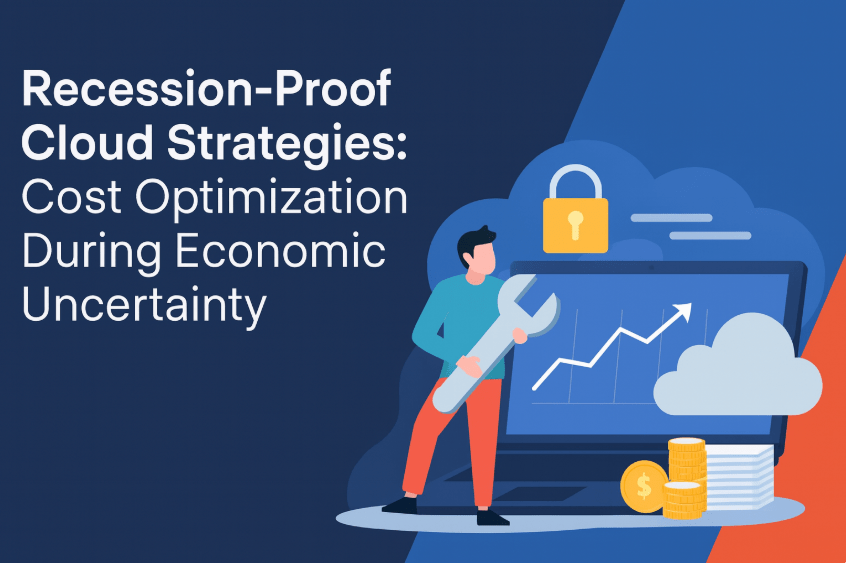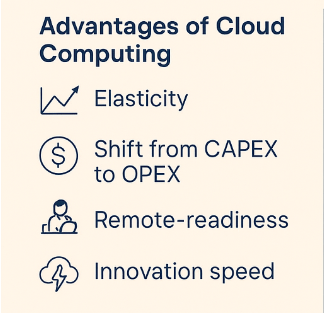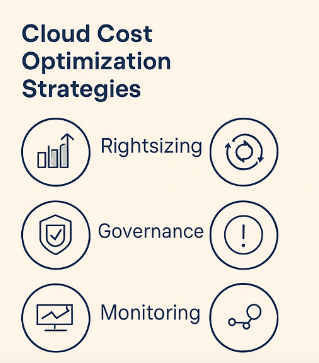
Economic downturns test the resilience of every business model. Organizations that once enjoyed healthy growth suddenly face revenue declines, tighter budgets, and mounting pressure to achieve more with less. During such times, cloud computing and SaaS solutions are both a lifeline and a challenge. While they provide flexibility and scalability, without careful oversight, they can also drain resources through hidden costs, over-provisioning, and underutilized subscriptions.
The key to thriving—not merely surviving—in a recession lies in building recession-proof cloud strategies. To set the foundation, businesses must first understand essential cloud computing terminology, which provides clarity when evaluating expenses and optimization opportunities. These strategies combine cost optimization, operational efficiency, and intelligent technology adoption to ensure that businesses maintain agility while keeping expenditures under control. This article explores best practices, pitfalls to avoid, and actionable tactics to recession-proof your cloud and SaaS investments.
Why Cloud Matters During Economic Downturns
Cloud infrastructure and SaaS platforms provide several inherent advantages during economic uncertainty:
- Elasticity – Companies can scale resources up or down in real time, aligning usage with fluctuating demand.
- Shift from CAPEX to OPEX – Instead of heavy upfront investments in hardware, firms pay for services monthly or annually.
- Remote-readiness – With distributed teams now the norm, cloud-native apps ensure continuity and collaboration.
- Innovation speed – Cloud platforms provide immediate access to advanced technologies like AI, machine learning, and big data analytics.
The 2019 pandemic accelerated the shift to cloud and SaaS as remote collaboration became essential. The impact of COVID-19 on cloud adoption highlighted the importance of flexible infrastructure and scalable SaaS tools when business continuity is threatened.
However, these benefits come at a cost. Without strong governance, organizations often accumulate unused licenses, oversized virtual machines, or duplicate SaaS subscriptions. A downturn magnifies these inefficiencies, making cost optimization a board-level priority.

Core Principles of Recession-Proof Cloud Strategies
1. Visibility and Transparency
The first step in optimization is knowing what you spend and where. Many enterprises struggle with shadow IT, where different teams procure cloud services or SaaS apps without central oversight. Platforms like Binadox solve this by centralizing multi-cloud and SaaS cost data into unified dashboards, enabling finance and IT leaders to see the full picture.
2. Prioritization of Business-Critical Services
Not all workloads carry the same weight during a recession. Critical applications that drive revenue or customer engagement must remain a priority. Non-essential or redundant workloads, on the other hand, should be paused, downsized, or eliminated.
3. Automation and Rightsizing
Rightsizing involves adjusting resource allocation to actual usage patterns. For instance, reducing VM sizes, shutting down idle instances, or switching to more efficient SaaS tiers. Automation further enhances savings by applying policies that automatically de-provision resources after a period of inactivity.
4. Governance and Policy Enforcement
Organizations that establish clear cloud governance policies—such as approval workflows, tagging rules, and budget caps—achieve greater consistency and accountability. Governance prevents uncontrolled cloud sprawl and ensures that only authorized and necessary services are used.
5. Vendor Negotiation and Contract Optimization
Recessions are leverage points for renegotiating vendor contracts. Cloud providers and SaaS vendors often offer discounts, extended payment terms, or reserved capacity pricing during downturns. Smart procurement strategies lead to significant savings.

SaaS Cost Optimization During Recession
The SaaS Explosion
Over the last decade, SaaS adoption has skyrocketed, with businesses using an average of 80+ SaaS applications. According to Gartner’s SaaS growth strategy insights, this rapid expansion is expected to continue, though companies must now shift focus from growth to value-driven management during recessions.
While this proliferation enables innovation and collaboration, it also creates fragmented spending. During economic uncertainty, businesses must shift from growth-driven SaaS adoption to value-driven SaaS management. Instead of simply adding new applications to solve every operational challenge, organizations should re-evaluate whether existing tools can be maximized to cover multiple functions. This mindset moves procurement away from “best of breed at any cost” to a more deliberate, ROI-driven approach.
Common Sources of SaaS Waste
- Duplicate subscriptions across departments.
- Uncancelled renewals for abandoned apps.
- Oversized plans with unused features.
- Low user adoption of licensed seats.
These inefficiencies compound during recessions because subscription renewals often fly under the radar, quietly draining budgets while resources are stretched thin. What seems like a minor unused license or an unnecessary upgrade can snowball into thousands—or even millions—of wasted dollars annually for large enterprises.
Strategies for SaaS Cost Optimization
- Centralized Procurement – Prevents uncontrolled SaaS adoption by routing all purchases through a central approval process.
- Usage-Based Rightsizing – Periodic audits identify underused licenses and adjust them to actual usage.
- Renewals Calendar – Tracking renewal dates avoids surprise charges and gives negotiation leverage.
- SaaS Governance Policies – Standardize onboarding and offboarding to prevent “ghost licenses” for former employees.
- Spend Management Tools – Platforms like Binadox automate SaaS spend analysis, detect redundancies, and provide actionable cost-saving recommendations.
During recessions, these measures become more than operational best practices—they evolve into survival tactics. Companies that adopt SaaS governance and cost optimization practices are not merely cutting costs but also building resilience. By consolidating duplicate tools, scaling licenses to actual usage, and negotiating flexible contracts, businesses can free up significant resources without disrupting productivity. Moreover, aligning SaaS portfolios with long-term business priorities ensures that critical applications receive investment while redundant or underutilized services are retired.
Cloud Cost Optimization Framework
Rightsizing Compute and Storage
One of the fastest ways to optimize cloud spending is by adjusting instance sizes, storage tiers, and resource allocation. For example, organizations often pay for provisioned IOPS storage or GPU instances that go unused during slow demand cycles. Rightsizing matches resources to workload demand.
Leveraging Reserved and Spot Instances
AWS, Microsoft Azure, and GCP offer reserved and spot pricing options. Reserved instances provide discounts for committing to long-term usage, while spot instances allow businesses to purchase spare capacity at a fraction of the cost—ideal for non-critical workloads.
Implementing Automation Rules
Automation helps enforce policies such as:
- Shutting down development environments after business hours.
- Scaling resources automatically based on demand thresholds.
- Applying security and compliance scans to prevent misconfigurations.
Binadox, for instance, allows organizations to create automated rules that trigger corrective actions when conditions are met, ensuring consistent savings.
Monitoring and Anomaly Detection
Unexpected cost spikes can cripple budgets during a recession. Continuous monitoring with anomaly detection alerts ensures rapid response to cost surges. Whether caused by misconfigurations, unauthorized usage, or sudden workload shifts, early detection minimizes financial impact.

Overcoming Challenges in Cloud Cost Optimization
Shadow IT and Lack of Accountability
One of the most persistent obstacles is the prevalence of shadow IT—applications, SaaS subscriptions, or cloud resources procured by individual employees or departments without approval from IT or finance. While often well-intentioned, shadow IT leads to duplication of services, inconsistent security practices, and unmonitored costs. The result is fragmented visibility that makes true cost optimization impossible. To overcome this, organizations must enforce stricter procurement policies, promote centralized reporting, and leverage discovery tools that automatically detect unmanaged apps and services across the environment. By shining a light on shadow IT, companies not only regain cost control but also reduce risks tied to compliance and security.
Complexity of Multi-Cloud Environments
Enterprises often embrace multi-cloud architectures to avoid vendor lock-in, improve redundancy, and optimize for different workloads. However, each cloud provider comes with its own pricing model, billing structure, and discount schemes. What looks cost-effective in AWS may be expensive in Azure or GCP, making cross-comparison difficult. Additionally, siloed billing systems mean financial teams often lack a single source of truth. This complexity leads to inefficiencies and missed opportunities for savings. To address this, companies should adopt cost management platforms capable of aggregating spend data from multiple providers, normalizing formats, and applying advanced analytics to identify optimization opportunities across the entire multi-cloud footprint.
Resistance to Change
Even when cost-saving opportunities are clear, organizational resistance can slow implementation. Engineers may hesitate to resize workloads for fear of performance drops, while business units may push back against removing SaaS tools they prefer, even if duplicates exist elsewhere. This resistance often stems from uncertainty—teams worry that optimization will disrupt workflows or limit innovation. To overcome this challenge, leadership must clearly communicate the rationale behind cost optimization, showing how savings support broader business resilience during economic uncertainty. Involving stakeholders in decision-making, piloting changes on non-critical workloads, and demonstrating measurable savings can all help build trust and buy-in.
The Role of Binadox in Recession-Proof Strategies
Binadox plays a pivotal role in enabling organizations to weather economic downturns. Its platform provides:
- Unified Cloud & SaaS Dashboards – Consolidated visibility of all cloud providers and SaaS apps.
- Renewals Calendar & License Manager – Prevents surprise renewals and underutilized licenses.
- Rightsizing Recommendations – AI-driven optimization for cloud workloads.
- Spend by Tags & Teams – Granular visibility into departmental costs.
- Automation Rules & Alerts – Immediate corrective actions for anomalies.
- IaC Cost Tracker – Cost estimates for infrastructure-as-code deployments.
By combining transparency, automation, and governance, Binadox empowers businesses to achieve savings of up to 30% while maintaining operational efficiency.
Future Outlook: Building Resilient Cloud Architectures
Recessions eventually end, but the optimization practices adopted during downturns often become long-term advantages. Organizations that implement recession-proof cloud strategies will emerge stronger, with leaner operations and sustainable cost structures.
According to Cisco’s technology trends report, the future of cloud computing will be shaped by AI-driven optimization, SaaS consolidation, and hybrid cloud-edge strategies, all of which help organizations remain resilient during uncertainty.
Key future trends include:
- AI-driven cost optimization – Machine learning will increasingly automate rightsizing and anomaly detection.
- SaaS consolidation – Businesses will streamline toolsets, favoring integrated platforms over fragmented solutions.
- FinOps maturity – Finance and IT will collaborate more closely to embed cost accountability into business processes.
- Edge-cloud synergy – Workloads will shift toward hybrid models, combining edge computing with central cloud services.
Conclusion
Economic uncertainty does not have to derail digital transformation. By adopting recession-proof cloud strategies, businesses can reduce waste, optimize costs, and maintain resilience. The core lies in visibility, automation, governance, and vendor negotiation. Tools like Binadox provide the actionable insights and automation needed to achieve these goals effectively.
Recessions may force difficult choices, but they also present opportunities: the opportunity to refine cloud usage, cut inefficiencies, and emerge as a stronger, leaner, and more competitive organizatio

